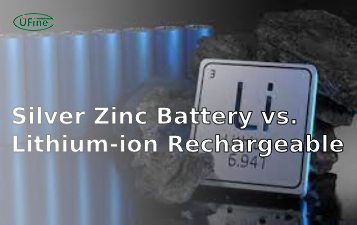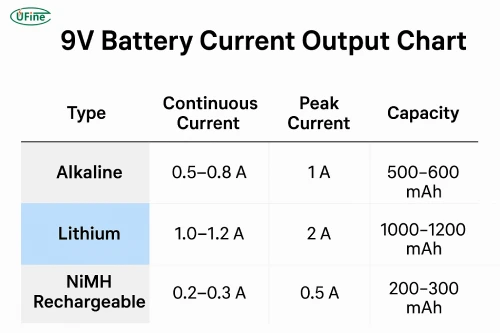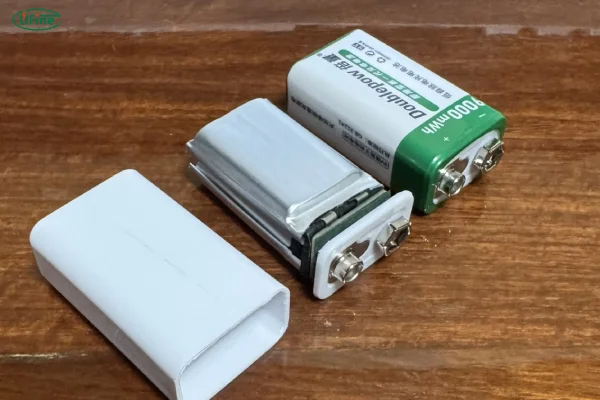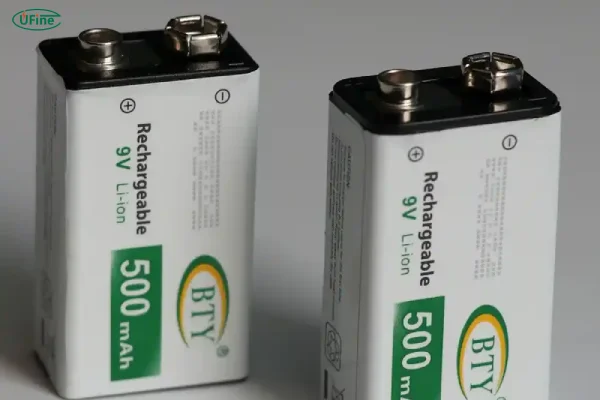
- Part 1. Understanding amps: what are amperes in batteries?
- Part 2. How many Amps can a 9V battery supply?
- Part 3. How much current can a 9V battery provide?
- Part 4. Capacity of different types of 9V batteries
- Part 5. Buying the best 9V battery: key considerations
- Part 6. How long does a 9V battery last?
- Part 7. How long does a 9V battery need to be recharged?
- Part 8. What battery can replace a 9V battery?
- Part 9. Final words
Quick Answer: A standard 9V alkaline battery can supply about 500–800 mA (0.5–0.8 amps) under continuous load, while lithium 9V batteries can reach up to 1.2 amps.
In this detailed guide, we’ll explore 9V battery amps in depth, breaking down what they mean, how they affect battery performance, and providing you with a comprehensive understanding of 9V battery capacity, discharge rates, and more. Let’s dive into the world of amperes, voltage, and battery performance!
Part 1. Understanding amps: what are amperes in batteries?
Before discussing how many amps a 9V battery delivers, let’s first understand what “amps” actually means in the context of batteries. Amps (short for amperes) are the units used to measure the amount of electric current flowing through a circuit. This current is essentially the flow of electrons, and it represents the power available for your device.
In simpler terms, if a battery is like a water pump, the amperes represent how much water (electricity) is being pumped through the system at any given time. A battery with higher amps can supply more power to a device at a faster rate, while a battery with lower amps provides less energy at a slower pace.
In practical terms, the amperage of a battery directly affects how quickly the battery is drained. Devices that draw more current (like high-power tools or audio equipment) require batteries with higher amperage to operate effectively.
Part 2. How many Amps can a 9V battery supply?
Quick Answer:
- Alkaline 9V: 500–800 mA continuous, up to 1A peak.
- Lithium 9V: 1000–1200 mA continuous, up to 2A peak.
- Rechargeable NiMH 9V: 200–300 mA continuous.
1 amp = 1000 milliamps (mA) — so a 9V battery typically delivers 0.5–1.2 amps depending on type.
9V Battery Current Output by Type (Comparison Table)
| Type | Continuous Current | Peak Current | Capacity (mAh) | Ideal For |
|---|---|---|---|---|
| Alkaline | 0.5–0.8 A | 1 A | 500–600 | Smoke alarms, toys |
| Lithium | 1.0–1.2 A | 2 A | 1000–1200 | Guitar pedals, sensors |
| NiMH Rechargeable | 0.2–0.3 A | 0.5 A | 200–300 | Frequent-use devices |
Now that we understand the basics of amperes, let’s focus on the 9V battery. Generally, a 9V battery is rated to provide around 500 to 800 milliamps (mA) of continuous current. To put it in perspective, 1 amp (A) is equal to 1,000 milliamps, so a 9V battery will typically deliver between 0.5 to 0.8 amps.
However, it’s important to note that this current output isn’t fixed. The amperage a 9V battery provides can fluctuate depending on several factors, including the load of the device it’s powering, the age of the battery, and the battery’s chemistry.
Part 3. How much current can a 9V battery provide?
The current that a 9V battery can provide isn’t just about its average output. There are several key factors that influence how much current can be drawn from a 9V battery. Let’s break it down further:
-
Discharge Current: When using a 9V battery, the discharge current is the amount of current the battery can consistently provide over a period of time. Typical continuous discharge for common devices is 50–200mA, but under heavier loads, alkaline 9V batteries can deliver up to 500–800mA. However, this can vary based on the load placed on the battery. Higher-power devices may require more current and will drain the battery faster.
-
Peak Current: A 9V battery can typically handle brief spikes in current demand, known as peak current. High-performance lithium types may briefly reach 2A peak; standard alkaline types usually peak around 1A. However, this high current draw is unsustainable and will quickly deplete the battery.
-
Maximum Output: Most 9V batteries have a maximum current output they can deliver before they start to experience performance issues or potential overheating. This value can be as high as 2 amps in some specialized batteries, but in most everyday uses, the maximum output will be lower.
Part 4. Capacity of different types of 9V batteries
While amperes measure the current a battery can supply, capacity refers to the total energy a battery can store. Capacity is measured in milliampere-hours (mAh), which indicates how long a battery can provide a certain current before it runs out of charge.
Different types of 9V batteries have varying capacities, which makes a big difference in how long they last and how much power they can deliver. Here’s a breakdown of the most common types:
-
Alkaline 9V Batteries: Alkaline 9V batteries are among the most commonly used. They generally offer a capacity of 500 to 600 mAh. This means they can supply a relatively low current over a longer period of time. Alkaline batteries are affordable and perfect for devices that don’t require high drain, like smoke alarms or basic remote controls.
-
Lithium 9V Batteries: Lithium-based 9V batteries provide a much higher capacity, ranging from 1,000 to 1,200 mAh. These batteries can provide a higher current over a longer period and last several times longer than alkaline batteries. Lithium batteries are ideal for high-drain devices like guitar pedals or wireless transmitters.
-
Rechargeable NiMH 9V Batteries: Rechargeable Nickel-Metal Hydride (NiMH) 9V batteries have a lower capacity, typically around 200 to 300 mAh, but they can be recharged hundreds of times. These batteries are great for people looking for a sustainable, cost-effective solution for frequently used devices. Keep in mind, though, that rechargeable batteries generally don’t provide as much power per charge as their alkaline or lithium counterparts.
9v Lithium or Alkaline Battery: Which One’s More Reliable?
Part 5. Buying the best 9V battery: key considerations
When purchasing a 9V battery, several factors should guide your decision:
-
Battery Chemistry: As discussed, different chemistries offer varying capacities and performance characteristics. Alkaline batteries are the most affordable, while lithium batteries last longer and provide higher power output. NiMH rechargeable batteries are ideal for long-term use, but they have lower initial capacity.
-
Capacity Needs: If you need your device to last a long time on a single charge, lithium is your best bet. However, if you’re using a low-drain device like a clock or smoke alarm, an alkaline 9V battery might suffice.
-
Reusability: Consider whether you’ll need to replace the battery often or if you want a rechargeable option. Rechargeable 9V batteries can be recharged up to 500 times, saving you money in the long run, but they generally have a lower initial capacity.
-
Price: While lithium and rechargeable batteries cost more upfront, their long lifespan can make them more cost-effective in the long run, especially for high-drain or frequently used devices.
Part 6. How long does a 9V battery last?
The lifespan of a 9V battery depends on several factors, including its capacity and the power consumption of the device it powers. On average:
-
Alkaline 9V Battery: These batteries typically last 5 to 10 hours in moderate-power devices. In low-power devices like smoke detectors, they may last up to 6 months to a year.
-
Lithium 9V Battery: Lithium 9V batteries last significantly longer than alkaline ones, providing up to 20 to 30 hours of usage in high-drain devices.
-
Rechargeable NiMH 9V Battery: NiMH rechargeable 9V batteries last around 2 to 3 hours on a single charge, but they can be recharged up to 500 times, making them ideal for long-term use in devices you use often.
Part 7. How long does a 9V battery need to be recharged?
Rechargeable 9V batteries, such as those based on NiMH chemistry, require about 3 to 5 hours to recharge fully, depending on the charger used. Charging times can vary, but it’s essential to follow the manufacturer’s guidelines to avoid overcharging, which can damage the battery and reduce its lifespan.
Part 8. What battery can replace a 9V battery?
While 9V batteries are commonly used in smoke alarms, guitars, and other devices, there are some alternatives to consider:
-
AA Battery Holder: For certain low-power applications, you can use a holder designed to fit multiple AA batteries in place of a 9V. However, this setup might not provide the same voltage and capacity as a true 9V battery, so it’s important to check the compatibility with your device.
-
Li-ion 9V Rechargeable Battery: Lithium-ion (Li-ion) rechargeable batteries are becoming increasingly popular due to their high energy density and long lifespan. They can replace standard 9V batteries in most devices that require long-lasting power. However, ensure that the voltage matches your device’s specifications.
Part 9. Final words
In conclusion, understanding the amps in a 9V battery is essential for making the right choice for your devices. From understanding how much current it can provide to knowing the different types of 9V batteries available, it’s important to consider the current demands of your device, the battery’s capacity, and how long you expect the battery to last.
Whether you’re using an alkaline, lithium, or rechargeable 9V battery, knowing these details will help you make more informed decisions, extend the life of your devices, and ultimately save money in the long term.
Related Tags:
More Articles

What is the Difference Between Silver Zinc Battery vs. Lithium-ion Rechargeable?
Compare silver zinc and lithium-ion rechargeable batteries: energy density, cycle life, safety, cost, and uses in drones, medical devices, EVs, and electronics.
What are Watts and Watt Hours in Battery?
Understand watt vs watt-hour in batteries: key differences, how to calculate capacity, and why they matter. Includes free comparison table.
Best 10 Blood Pressure Monitor Battery Review: Finding the Most Reliable
Are you looking for a reliable Blood Pressure Monitor battery? Here is a complete guide with the top 10 best blood pressure monitor batteries.
Bluetooth Headphone Battery Guide: All You Need to Know
Maximize headphone battery life with expert tips! Learn how to charge, check, troubleshoot, and choose the best bluetooth headphone battery in 2025.
LiFePO4 Battery VS. Lithium-ion Polymer Battery: Which One Is Best?
Comprehensive comparison of LiFePO4 vs Lithium Ion Polymer batteries: energy density, safety, lifespan, cost. Find out which battery suits your needs in 2025.





